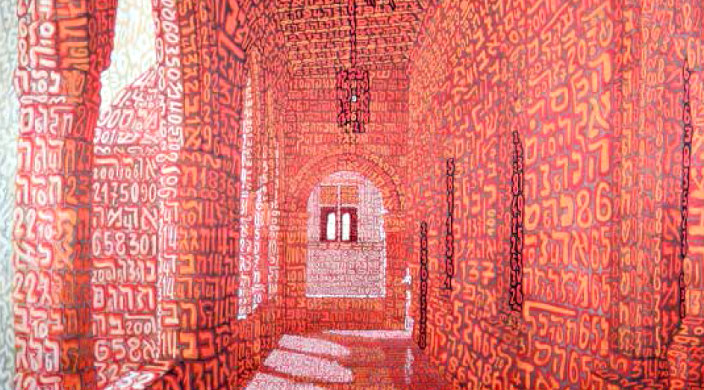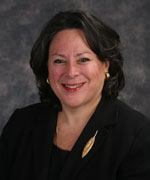
As the global language of humanity, numbers have also been integral to Jewish life, rituals, belief, and history from antiquity to our own day. In Paint by Numbers, a new exhibit at the HUC-JIR Museum in New York, more than 50 contemporary artists explore numbers and their symbolic meanings through a broad range of media.
Curator Laura Kruger explains,
“This exhibition illuminates how numbering creates a scaffold of order and continuity – virtually everything we are, do, and interface with is a number. Dates of disruption, disaster, triumph, or success are commemorated. Numbers underpin measurements of worth, marriage contracts, mathematical equations, diary date entries, lottery tickets, house numbers, the counting of time itself. The power of numbers as a source of inspiration and meaning is manifest in these works.”
The prevalence and symbolism of numbers in the Bible is described in such works as Richard McBee’s “Ten Trials of Abraham,” Sandra Bowden’s “Aaron’s Breastplate,” Joelle Dautricourt’s “Broken Tablets,” and Dorit Jordan Dotan’s “Noah’s Ark.” David Wander’s “Herzl and the Twelve Spies” imagines 20th-century notables as part of this biblical story. Judy Sirota Rosenthal’s tree-limb installation of “The Tribes of Israel” reunites Jacob’s offspring by including siblings Dina, Levi, and Joseph with their 12 brothers, after whom the biblical tribes are named.
The numerical basis for Jewish rituals are revealed in Tobi Kahn’s abstract bas relief sculpture for counting the Omer, the 49 days between Passover and Shavuot; Trix Rosen’s poignant drawing of mother and daughter binding their arm t’fillin seven times; Peachy Levy’s textile work “Many Paths to 613 Mitzvot,” and Jeffrey Schrier’s monumental Hanukkah lamp constructed of Israeli metal gasoline nozzles.
Personal and historic milestones are recorded in Japanese artist Tetsuya Noda’s daily illustrated diary recording the date of his conversion to Judaism, Barbara Green’s recollection of the 1492 expulsion of her family from Spain, and Holocaust survivor Riva Bell’s folk art painting expressing her joy on the May 14, 1948, establishment of the State of Israel.
The numerology of the Holocaust is commemorated in searing works, including Judy Glickman Lauder’s photograph of confiscated, numbered suitcases at Auschwitz and Donald Woodman’s tribute to a Dachau survivor who reveals his tattooed arm. Also on view are two of the memorial stolpersteine (stumbling stones) by Gunter Demnig and Peter Hess that are installed in the sidewalks in front of buildings throughout Europe, documenting the dates of birth and deportation to the death camps of the Jewish victims who once lived there.
The consequence of numbers is interpreted by Bunny Burson’s installation of “hanging chads,” reminding us of the importance of every single election vote in light of the 537 votes in the Florida polls that changed history in the 2008 Bush/Gore election. On a lighter note, John Hirsch’s collage of discarded lottery tickets wittily recalls his unlucky numbers and Larry Frankel’s “Kabbalah Bingo: The Winning Card,” includes numbers from two (the Tablets) to 304, 805 (the total number of letters in the Torah).
The plight of the contemporary world is expressed in Grace Graupe Pillard’s “Departures,” where the Amtrak station’s digital timetable is juxtaposed with images of a homeland security soldier and the homeless. John Lawson’s “Exodus – Diminishing Numbers” alludes to the extinction of species and our responsibility to the environment. Paul Weissman reflects on the explosive periodic table element 55, Caesium, an essential ingredient of the atomic clock, while Italian surrealist Tobia Rava’s silk tapestries express a Kabbalistic evocation of infinity through a spellbinding labyrinth of Hebrew letters and numbers.
In his exhibition catalog essay, Rabbi David Adelson, dean of Hebrew Union College-Jewish Institute of Religion’s New York campus, writes “Numbers are like any technology. They are, themselves, morally neutral. Using them does not automatically support life, or destroy it. The result depends on the intention we bring.”
These intentions are depicted in memorable works of profound insight and meaning.
Paint by Numbers is on view from September 8, 2016 through June 30, 2017 at the HUC-JIR Museum, One West Fourth Street, New York City; Group tours and information: museumnyc@huc.edu or 212-824-2218
Related Posts

Remembrance and Beyond: International Holocaust Remembrance Day

Combatting Loneliness, Poverty, and Trauma in the Lives of Holocaust Survivors


